Top 10
8 Best Word Processing Software to Use in 2023
Published
3 years agoon
By
Kai Kelis
The amount of documents written in an organization comes in large volumes. Managers, marketers, entrepreneurs, and individuals jot down quick notes or write long-form content daily. With the help of word processing software, this mundane and time-consuming task is made easier and faster. Here are free and paid word-processing software tools you can try.
1. Google Docs
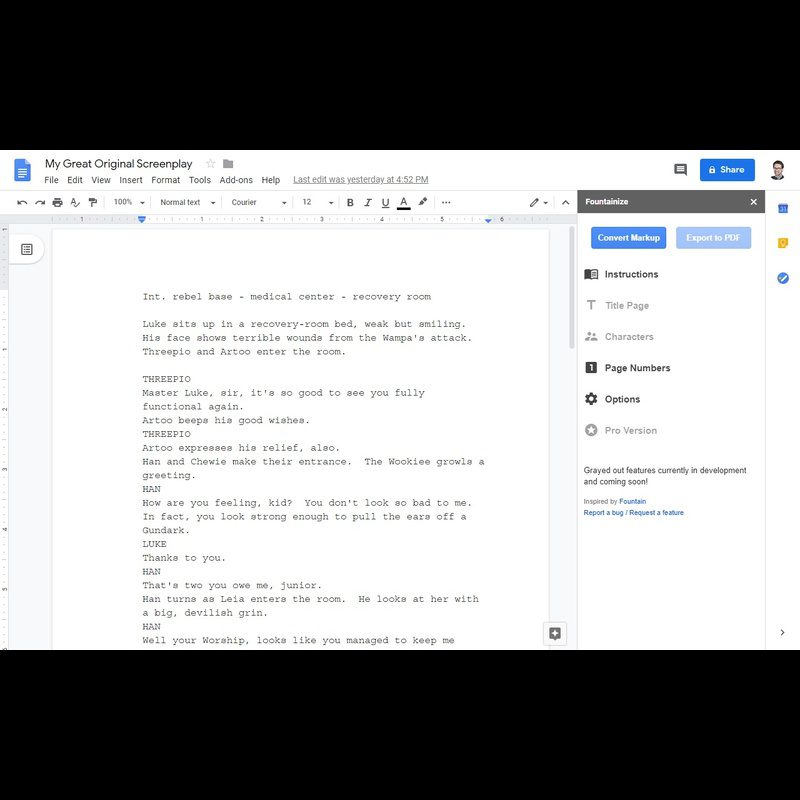
Everyone has undeniably heard of Google Docs. This cloud-based word-processing program is a team’s go-to for collaborating on documents. It has a clean interface packed with many helpful features when editing your document. Since it’s cloud-based, you can access it anywhere and from any device with a Google Doc app.
Features:
- Templates for faster writing
- Table of content for easy navigation
- Work in offline mode
- Personal dictionary
- Voice typing to enter text
- Bookmarks for quick reference
- Version history to monitor changes
- E-signature tool
Pricing:
- Business Starter $5.40/user/month
- Business Standard $10.80/user/month
- Business Plus $18/user/month
- Enterprise (Contact sales)
Visit website.
2. Microsoft Word

Image Credit: TechRepublic
Microsoft Word was one of the first-ever word-processing platforms before the cloud-based online tools took over. It’s a powerful word processor that anyone can use, from jotting down notes and writing meeting minutes to creating blog posts and reports.
Features:
- Check grammar, capitalization, spelling, punctuation, and more
- Share documents with anyone
- Add comments and suggest changes in real-time
- Save documents to OneDrive so that anyone can access them from any device
- Offers customizable templates and content
Pricing:
- Microsoft 365 Apps for Business $8.25/user/month
- Microsoft 365 Business Standard $10/user/month
Visit website.
3. Grammarly
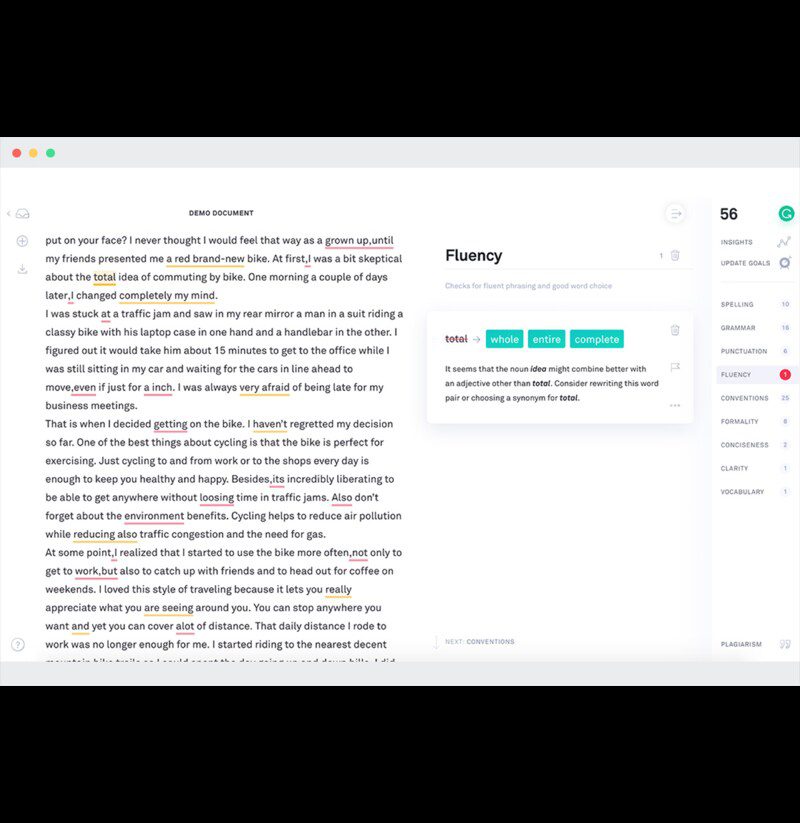
Image Credit: UIT
Writers, editors, entrepreneurs, and marketers have used Grammarly to proofread and edit write-ups. The best thing about this word-processing software is it provides fantastic integrations with many other apps. It can be downloaded as a browser extension to ensure everything is error-free.
Features:
- Catch grammatical errors, typos, insufficient punctuation, etc.
- Full-sentence rewrites for hard-to-read sentences
- Custom style guides to ensure a unified voice within the team
- Available in more than 500,000 web, desktop, and mobile applications
Pricing:
- Free
- Premium $12/month
- Business $15/month
Visit website.
4. Scrivener
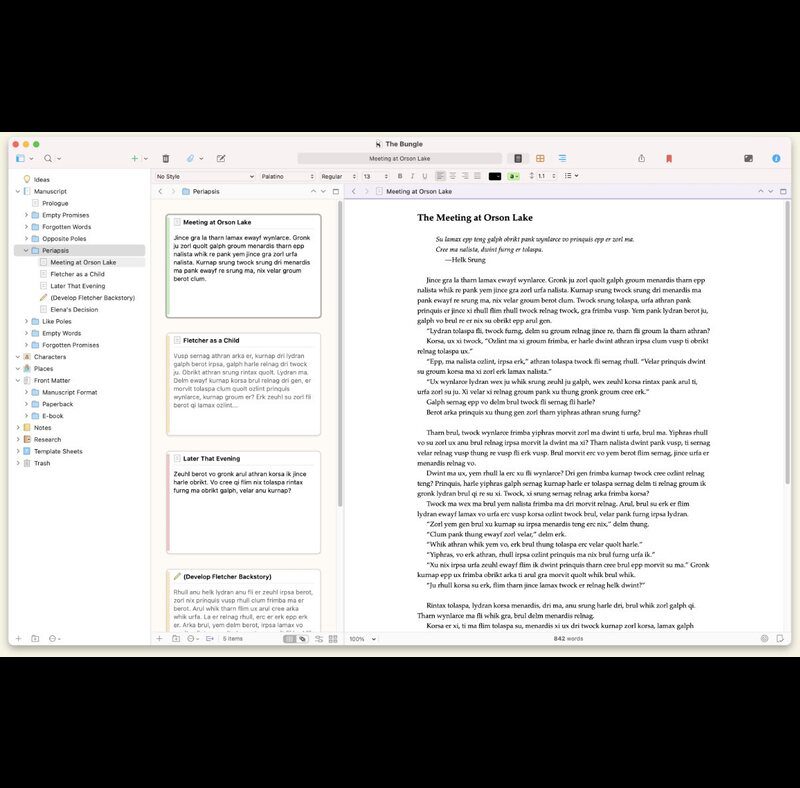
With versatility at its core, Scrivener caters to all kinds of writers. This word-processing program is tailored for long-form writing projects and fits lawyers, novelists, and blog writers. Users love this tool because it helps you compose thoughts and ideas by allowing you to scribble anything that comes up and squeeze it into the right place later.
Features:
- Powerful software that lets you gather writing materials and browse various parts
- Familiar text editing
- Use Styles to indent block quotes and make texts smaller at the same time
- Import writing projects from other apps to Scrivener projects
- Use the Corkboard to work with synopses you’ve written
- Check the overview of your manuscripts through Outliner
- Create templates and icons for new sections
- Keep track of progress like word count or writing history
- Take a snapshot before revising your docs so you can return to the former version
Pricing:
- 30-day free trial
- Standard License for macOS $59.99
- Educational License for macOS $50.99
Visit website.
5. Dropbox Paper
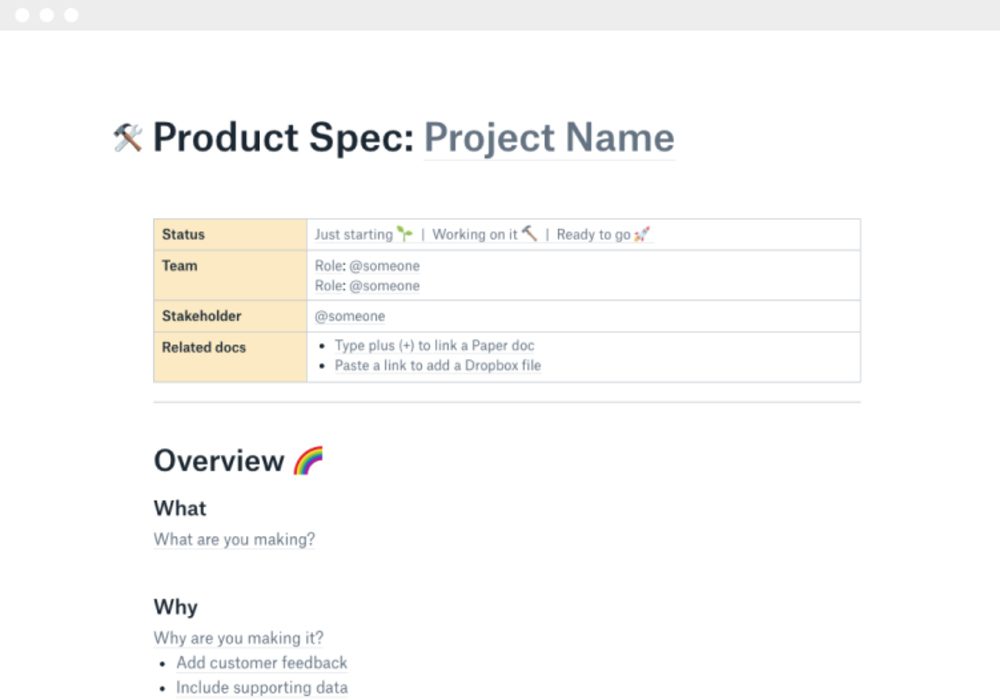
Image Credit: Capterra
Dropbox is one of the leading cloud-based services online, and Dropbox Paper is nothing new in companies worldwide. This is where you can keep everything on the same page by gathering all your meetings, docs, minutes, agenda, and task assignments in one place. This co-editing tool is also free, which makes it an even better alternative for startups!
Features:
- Enjoy task management tools that let you add due dates, assign tasks, and mention people
- Use annotations and emojis to add comments to any part of an image
- Integrates with your meeting calendar so you can easily find the particular document for a meeting
- Drop a link from your Pinterest board, YouTube channel, SoundCloud, or Google Map
- Capture inspiration on tablets and phones
- Transform docs into presentations
Pricing:
- Free
Visit website.
6. ProWritingAid
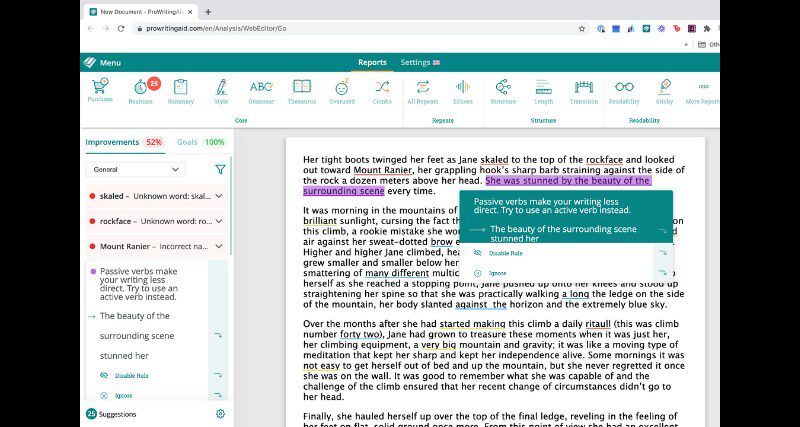
ProWritingAid is a robust word processor that offers unique features you won’t find elsewhere. It is built for every writer, and this tool dramatically improves your writing.
Features:
- Over thousands of spelling, grammar, and readability improvements
- 20 in-depth writing reports
- Use hand-coded rules to help you with your writing style and strength
- Enjoy in-app suggestions, videos, quizzes, and explanations
- Find the right words through Word Explorer and contextual Thesaurus
- Integrate with other apps, such as Open Office, Google Docs, Scrivener, etc.
- Install as browser extensions
- Use data visualization for an in-depth understanding of writing projects
Pricing:
- Free
- Premium $6.58/month
Visit website.
7. Evernote Web
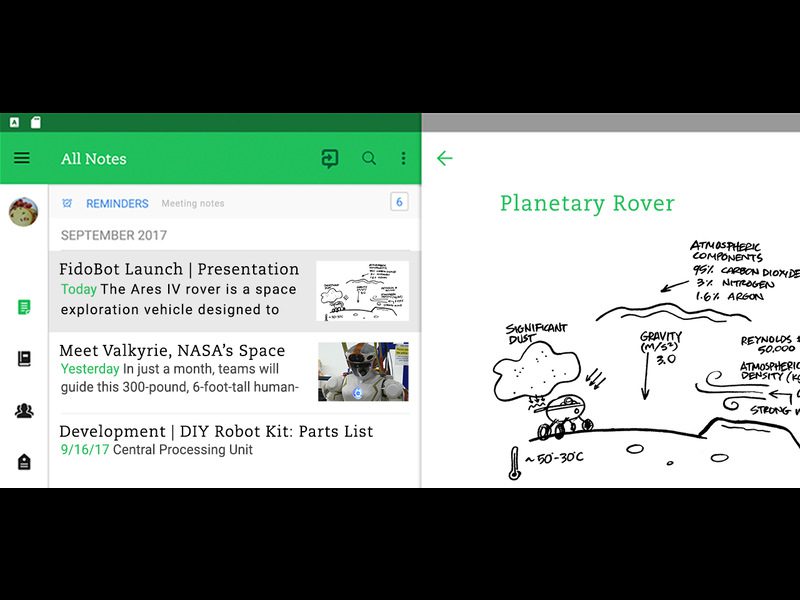
The genius behind Evernote was aware of the growing amount of information online and how the human brain couldn’t contain it. And this is why Evernote was born. It is meant to save your quick notes, schedules, and tasks in one place.
Features:
- Create a space for your essential ideas and information
- Quickly search your notes via keyword tags
- Add images, files, and to-do lists to notes
- Flexible organization
- Annotate and save images, web pages, and PDFs via the Web Clipper feature
- App integrations, including Slack, Outlook, Zapier, Google Drive, Gmail, Zapier, etc.
Pricing:
- Free
- Premium $7.99/month
- Premium Professional $9.99/month
Visit website.
8. JotterPad
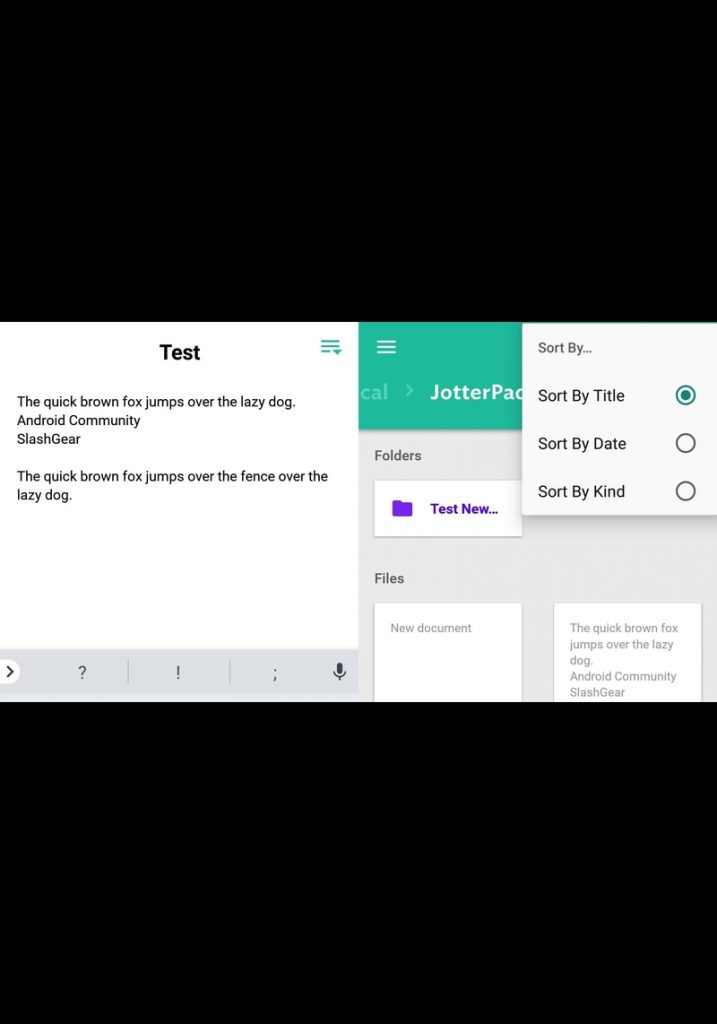
Image Credit: Android Community
Android users can make JotterPad their writing assistant. It lets you format your texts into MLA or APA papers, articles, mindmaps, screenplays, books, presentation slides, and more. This word-processing application is convenient as you can access it from any device, allowing ideas to flow.
Features:
- Simple text formatting via Lightweight Markup
- Seamless integration with Google Drive, Microsoft OneDrive, Dropbox, etc.
- Powerful integrated plugins
- Brainstorm and generate content with Wizard A.I.
- Embed images to markdown files
- Quick Research lets you search words
- Export to multiple formats
- Create formatted eBooks
- Over 100 beautiful-designed templates
Pricing:
- Free
- Monthly plan costs $6.99
- Annual plan costs $29.99
Visit website.
You may like

Are you looking to create a stunning presentation that keeps your audience engaged? It would be best if you had excellent presentation software to take your slides to new heights. Let’s review the ten best presentation software in 2026 so you can choose the best for your business.
1. Visme

Visme is a cloud-based presentation software that enables users to create visually engaging and interactive presentations, infographics, and other visual content. Its user-friendly drag-and-drop interface makes it easy for users to add text, images, charts, and other elements to their presentations. Likewise, it offers design options like custom color schemes, fonts, and layouts. On top of that are interactive features like videos which can engage audiences and make the presentation more interactive.
Visme also offers collaboration features that allow multiple users to work on a presentation simultaneously. Users can also share it for feedback and review.
Best for: Visme is perfect for small and large businesses, marketers, project managers, content creators, and educators.
Pricing:
- Personal: $12.25/month paid annually
- Business: $24.75/month paid annually
- Enterprise: Custom
2. Prezi
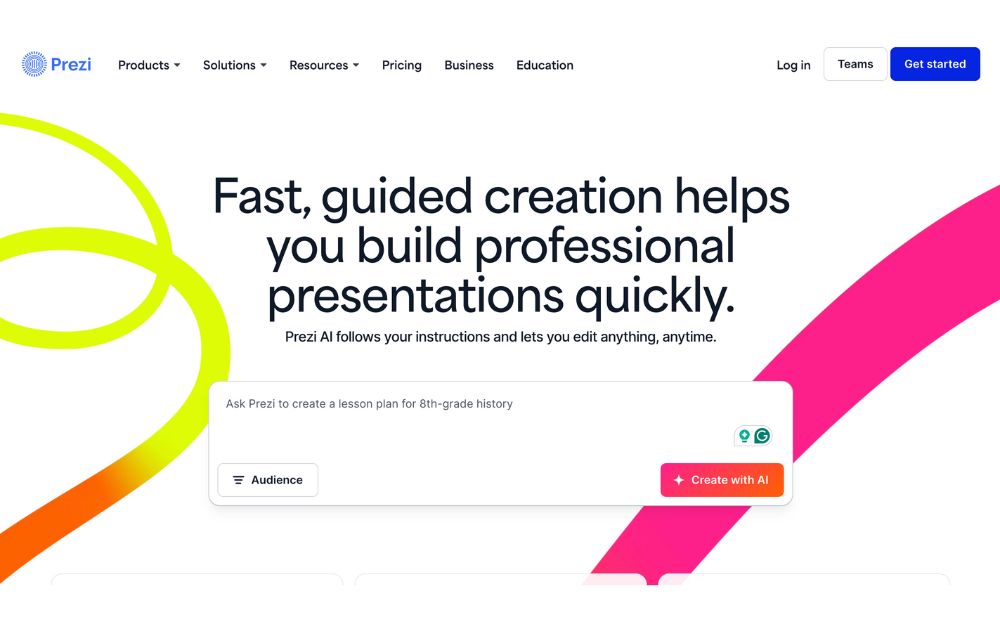
Prezi offers a great alternative to the typical presentation format that goes slide by slide. Prezi’s creative idea is to create an animated, non-sequential flow of slides with hidden topics and subtopics until you zoom in. While Prezi’s interface can be slightly complicated, it is a good option for people who want to add a creative touch to their slides.
Best for: Businesses and educators.
Pricing:
- Free plan: $0
- Plus: $15/month
- Premium: $25/month
- Teams: Starts at $39/month
3. Google Slides
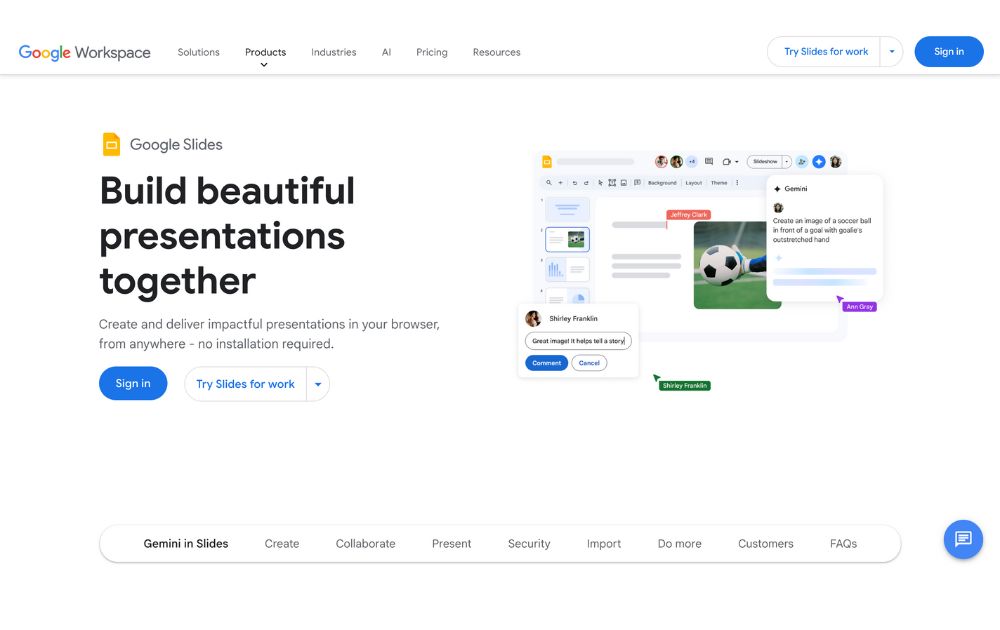
One of the most used tools online, Google Slides is a web-based presentation software part of the Google Suite of productivity tools. Google Slides is a web-based presentation software part of the Google Suite of productivity tools. It enables users to create, edit, and share presentations online, and it is similar in functionality to other presentation software such as Microsoft PowerPoint.
With Google Slides, users can create a new presentation from scratch or use one of the many templates provided by Google. Users can add text, images, charts, and other elements to their presentations using a simple drag-and-drop interface. Google Slides also offers a wide range of design options, including custom color schemes, fonts, and layouts, as well as the ability to add animations, transitions, and other effects to slides.
Best for: Business professionals, educators and students
Pricing:
- Free to use for anyone with a Google account.
- Plans for business accounts start at $6.30/user/month.
4. Keynote
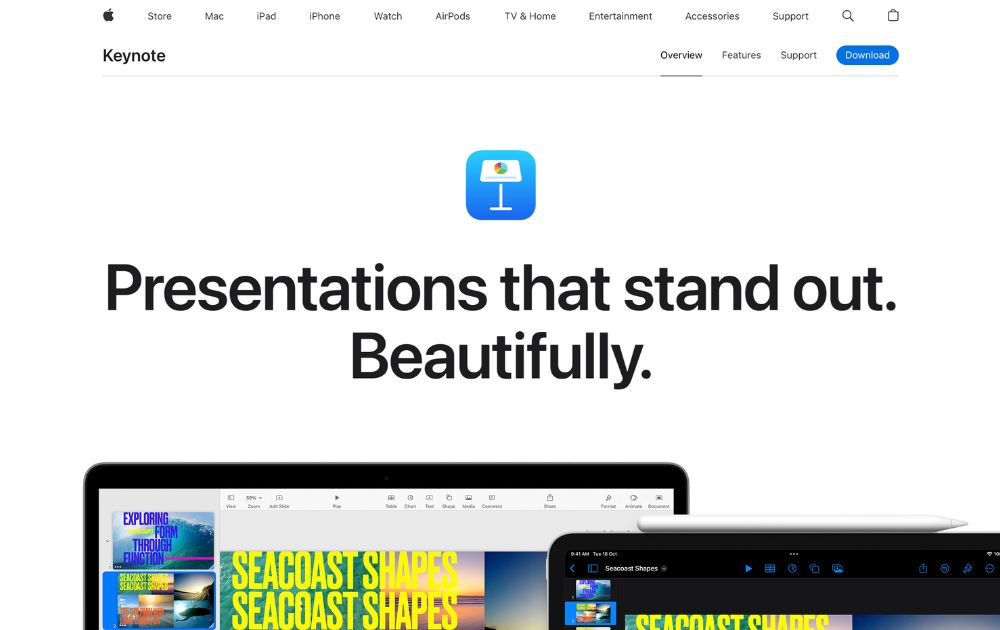
Keynote is an Apple presentation software and one of the original alternatives to Microsoft’s PowerPoint. The best thing with Keynote is that it is the most similar to PowerPoint and Google Slides.
Best for: Keynote is good for businesses, educators, and individuals.
Pricing: Free for anyone with Apple ID
5. Microsoft PowerPoint
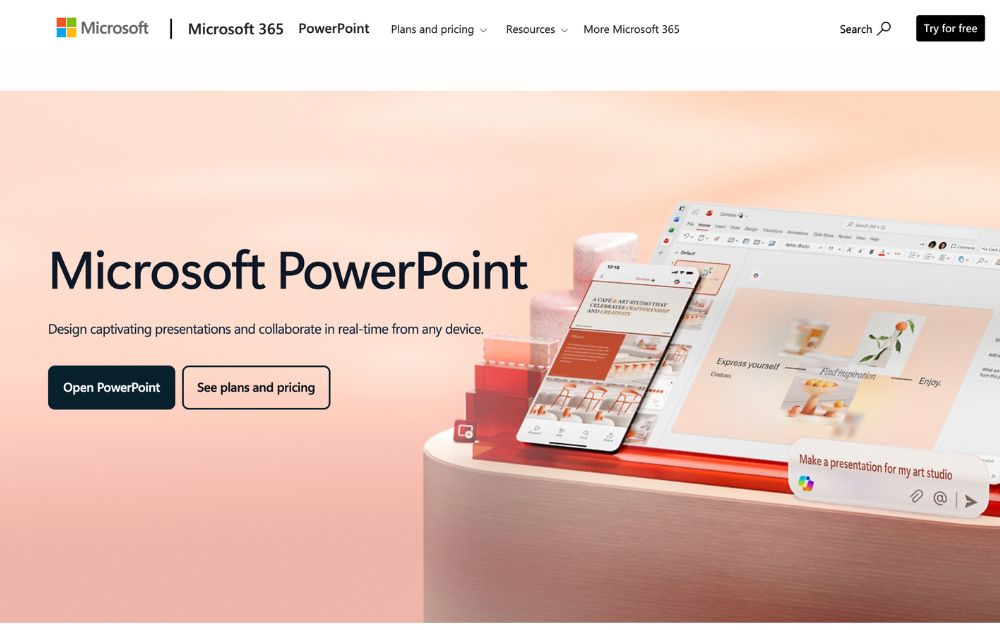
Microsoft PowerPoint is the world’s most widely used presentation software. It is similar in functionality to other presentation software such as Apple Keynote and Google Slides.
PowerPoint also offers collaboration capabilities, including sharing presentations for feedback and review. It also allows users to work on presentations with other users simultaneously. Plus, it enables users to export their presentations in PDF, PPTX, and JPG formats.
Best for: Businesses, individuals, students, teachers and individual who use a Windows PC or device.
Pricing:
- Free to download on desktop or mobile devices
- Microsoft 365 Personal starts at $9.99/month
6. Ludus

Ludus is one of the coolest presentation tools available online. The main attractions of Ludus are the clean black screen to edit on and the number of integrations that provide importing capabilities for all sorts of content.
Best for: Designers and business owners
Pricing:
- Starts at $14.90/month for teams of 1-15 people.
- Offers a 30-day free trial
7. Slides
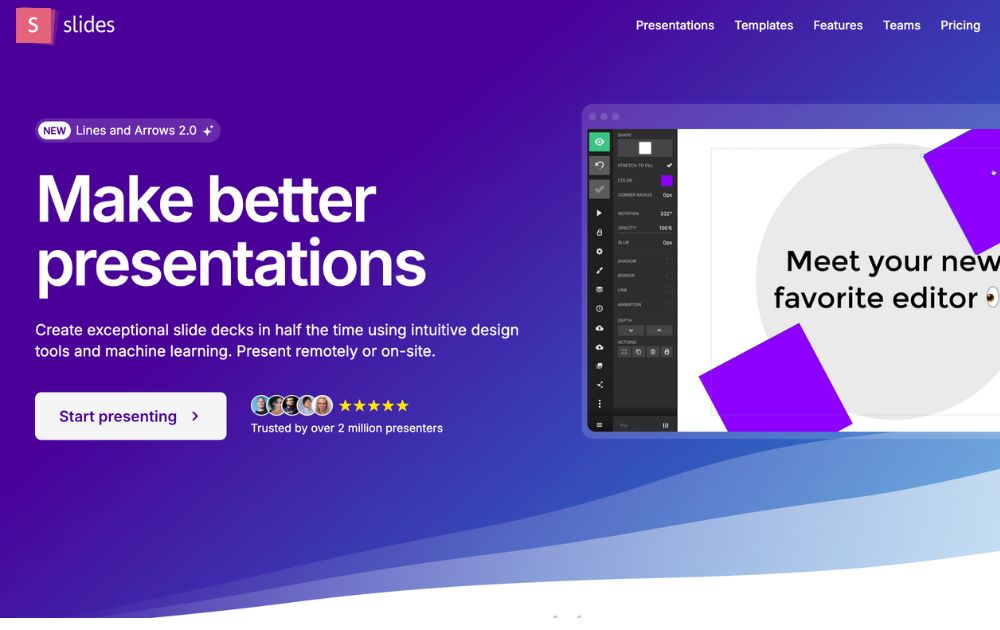
Slides promotes itself as “pixel-perfect” presentation software. Its editor includes a built-in grid to help with composition. Slides have a lower cost at the highest price tag, which suits smaller businesses.
Best for: Small business owners, startups, and individuals.
Pricing:
- Free plan
- Paid plans start at $5/month
8. Slidebean
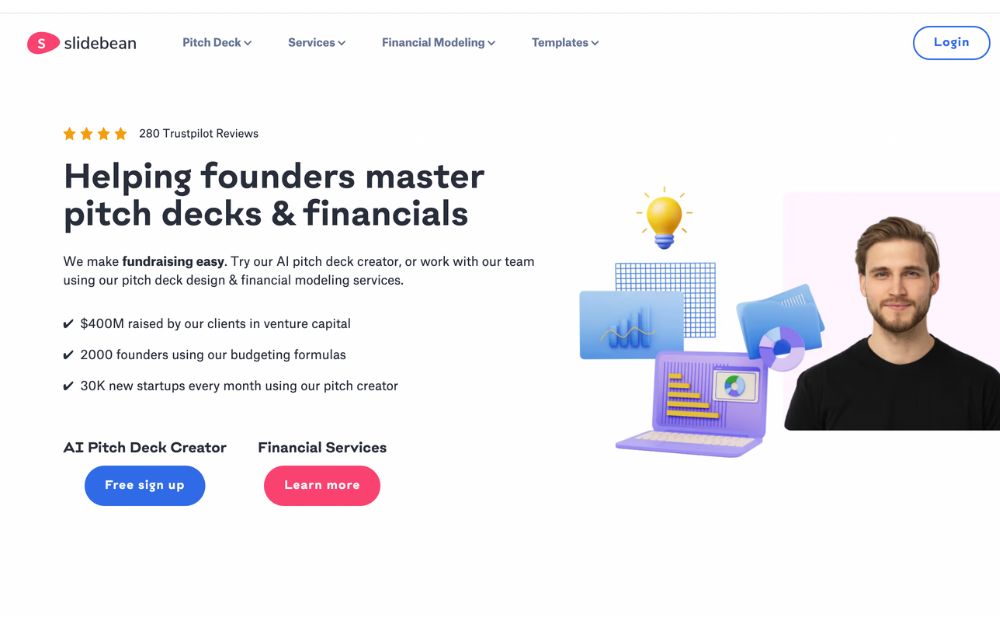
SlideBean is a cloud-based presentation software that enables users to create visually engaging and professional presentations quickly and easily. The software is developed as user-friendly and intuitive, making it easy for users to create high-quality presentations without any design experience.
Slidebean also takes pride in its AI pitch deck creator, which offers a fast way to create a presentation.
Best for: Small businesses, startups, and entrepreneurs.
Pricing:
- Paid plans start at $12/month
9. Beautiful.ai
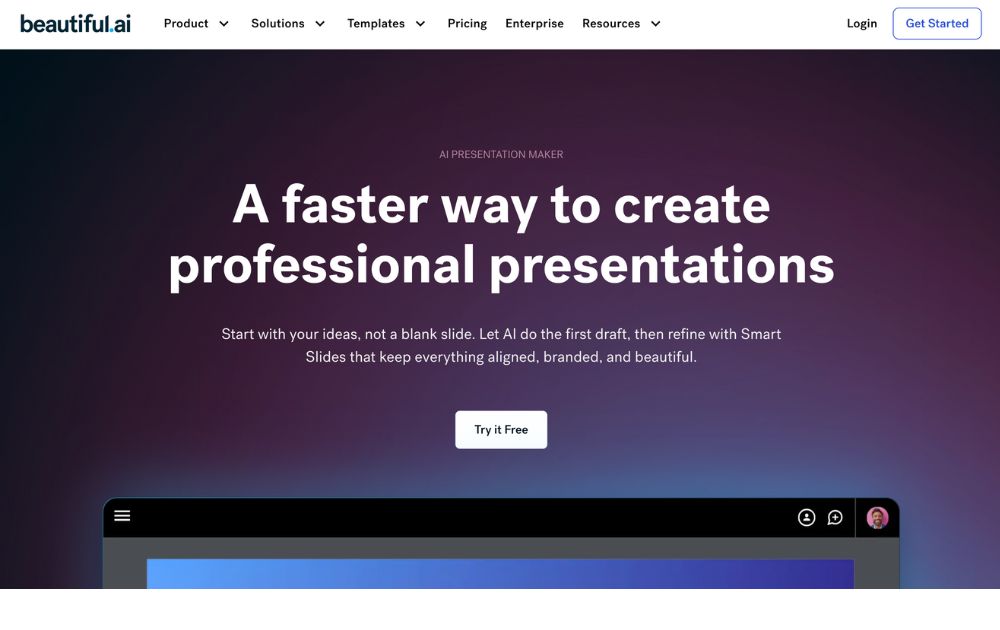
The cloud-based presentation software Beautiful.ai uses artificial intelligence to help users create visually stunning and professional-looking presentations. It has user-friendly and intuitive features, making it easy for users to create high-quality presentations without any design experience.
Best for: Beautiful.ai is a perfect tool for beginners and non-designers.
Pricing:
- Pro plan: $12/month, billed annually
- Team plan: $40/month, billed annually
- Offers a 14-day free trial
10. Zoho Show

Zoho Show is a web-based presentation software developed by Zoho, a company that provides a suite of productivity and collaboration tools. It is part of the Zoho Office Suite, which also includes tools such as Zoho Writer for word processing, Zoho Sheet for spreadsheets, and Zoho Meeting for online meetings.
With Zoho Show, users can create a new presentation from scratch or use one of the many templates provided. Users can add text, images, charts, and other elements to their presentations using a simple drag-and-drop interface.
Best for: Businesses, entrepreneurs, educators, and students.
Pricing:
- Free plan: up to 5 users
- Paid plans start from $2.5/user/month, paid annually
The Lowdown
Presentation software is the most common tool used to pitch an idea to investors and present proposals to prospective clients. Likewise, it is utilized by many organizations to introduce new products or services, train staff on new policies, or teach students new or complex concepts. The collection of the best presentation software will help broaden your choices regarding the tools that will improve your productivity.
Featured Image Credit: Photo by RDNE Stock project from Pexels
Technology
Top 10 Social Media Scheduler Apps to Automate Your Postings
Published
6 days agoon
December 11, 2025By
Skylar Lee
Social media managers have a lot on their plates. Creating, scheduling, and publishing posts can take up a huge chunk of their time. Fortunately, there are social media schedulers that can make your life easy. Here is our list of the 10 best:
Best Time and Day to Post on Social Media
Before we discuss the top 10 social media scheduling apps, you might wonder what the best time is to post on social media. Search Engine Journal and Sprout Social report that the best days to do it are Tuesday through Thursday. Meanwhile, the best time to post it is from 9 AM to 10 AM on those days. Avoid posting on Sundays.
But should you follow this?
The thing is, you don’t have to follow this social media best practice. One way to determine the best day and time to post for your business is through testing. For example, you can post at 2 PM ET for two weeks. Then, you can run a new test by switching to 3 PM after two weeks.
Now, let’s hop into the top 10 social media scheduler apps you can try.
1. Buffer

Buffer is an all-in-one social media management tool. Beyond being a social media scheduling tool, it can help you level up your social media marketing. You can add the first comment on your Instagram post and drive more traffic to your website. Aside from that, you have control before publishing your TikTok posts. Buffer will send you a notification, and you can approve the post before it goes out.
Pricing:
- Free
- Essentials – $6/mo/channel
- Team – $12/mo/channel
2. Hootsuite
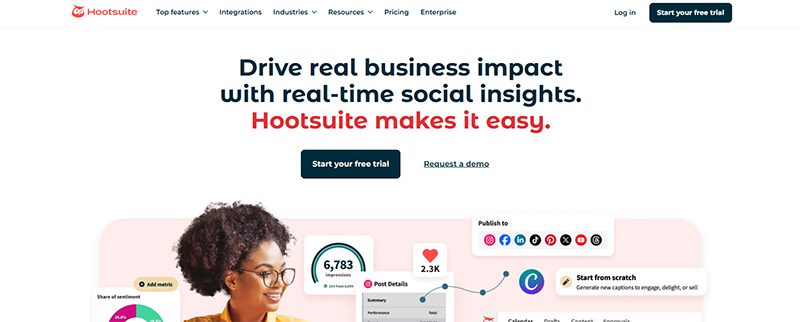
Hootsuite has been a well-known social media scheduler since the early 2010s. And the social media management tool is still the leading choice for 200,000+ businesses worldwide. Once you subscribe to Hootsuite, you can access its Hootsuite Planner. This enables you to schedule posts at any time. Plus, you can publish bulk posts on different social media channels, such as Facebook, Instagram, Twitter, and LinkedIn.
Pricing:
- Standard – $149/user/mo
- Advanced – $399/user/mo
- Enterprise – Contact sales
3. Agorapulse

If you need a collaborative social media scheduler, Agorapulse is one of the best options for your team. Team members can approve, reject, and leave feedback on draft posts before scheduling them. And if you manage different brands, you can organize and store files in folders. Aside from that, they have a rescheduling feature. This allows you to republish an old post and promote it again on your social media channels. Plus, if you’re on the go, they have an app too!
Pricing:
- Standard – $99/user/mo
- Professional – $149/user/mo
- Advanced – $199/user/mo
- Custom – Contact sales
4. SocialPilot
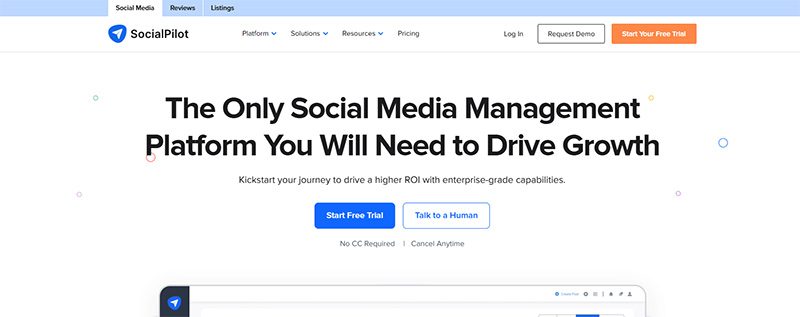
If you want an all-around social media scheduler, SocialPilot should be one of your top choices. You can publish posts on the following platforms:
- TikTok
- YouTube
- Google Business Profile
Aside from that, you can publish 500 posts in one go! You don’t have to worry about posting every week or month. You can be ahead and save time to do other tasks!
Pricing:
- Essentials – $30/mo
- Standard – $50/mo
- Premium – $100/mo
- Ultimate – $200/mo
- Enterprise – Contact sales
5. Sprout Social
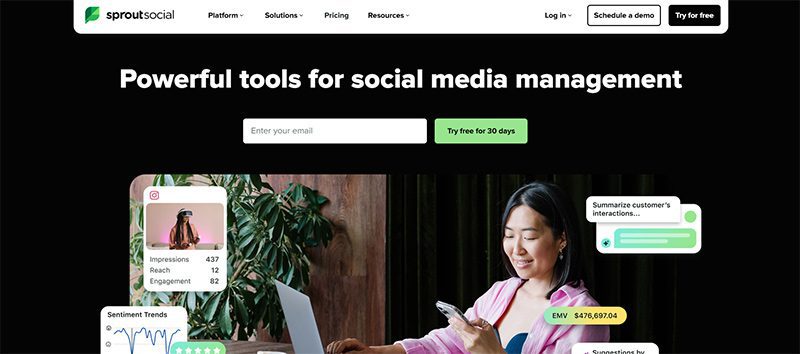
eCommerce businesses and agencies will benefit from using Sprout Social. For eCommerce businesses, they can integrate Shopify and Facebook Shops into Sprout Social. You can share your assets seamlessly on Sprout Social.
Meanwhile, agencies can benefit from Sprout Social’s asset library and message-approval workflows. This allows collaboration between your teams and clients.
Another useful feature of Sprout Social is content suggestions. If you run out of inspiration, Sprout Social can provide post ideas to help you create engaging content.
Pricing:
- Standard – $199/per seat/mo
- Professional – $299/per seat/mo
- Advanced – $399/per seat/mo
- Enterprise – Request a demo
6. MeetEdgar
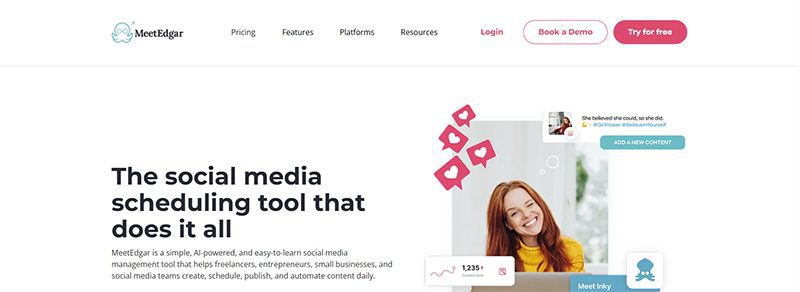
If you want to organize your social media posts according to categories, MeetEdgar should be one of your top choices. The platform allows you to create “Categories.” This enables you to organize the content you want to share on a specific social media platform. Aside from that feature, you can also easily upload your assets to your library and import content. Finally, get an overview of your postings for the next two weeks and review them before they’re published!
Pricing:
- Eddie – $29.99/mo
- Edgar – $49.99/mo
7. SocialBee
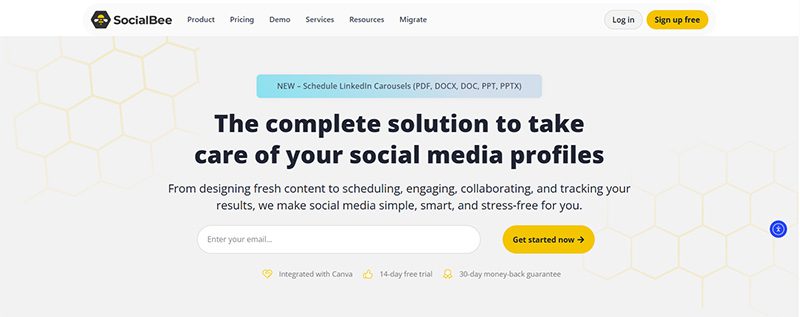
SocialBee is an excellent choice for social media experts who need more control over scheduling and publishing. You can choose to publish your content on ALL active social media platforms or select channels. Plus, SocialBee has a recurring schedule feature where you can repost old content at a later time. However, you can reverse the recurring feature by “expiring” a post. You can stop it when it reaches a number of shares or after a certain time.
Pricing (Standard):
- Bootstrap – $29/mo
- Accelerate – $49/mo
- Pro – $99/mo
Pricing (Agency):
- Pro50 – $179/mo
- Pro100 – $329/mo
- Pro150 – $449/mo
8. Later

Does your business love reposting user-generated content? Later is the best option for your business. You can follow a hashtag on the dashboard and share the post immediately on your social media channels. When uploading assets, you can use the library or connect your Google Drive or Dropbox account for seamless uploads. Finally, you can download their Chrome extension for faster sharing of images to share on your social media accounts.
Pricing:
- Starter – $25/mo
- Growth – $50/mo
- Scale – $110/mo
9. Pallyy
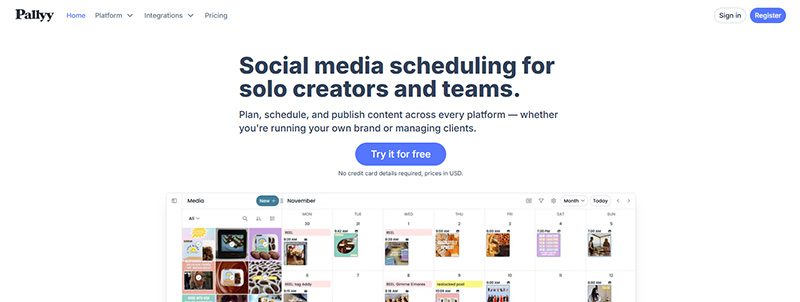
If you run an agency and need a social media scheduling tool, you should consider Pallyy as your primary social media management tool. You can create brand folders to organize posts. You can also select what post you’re publishing on the dashboard. Plus, it’s easy to collaborate with team members and leave drafts for next time. With Pallyy, you can post on popular social media sites like Facebook, Twitter, Instagram, and TikTok.
Pricing:
- Starter – $15/mo
- Pro – $25/mo
- Agency – $99/mo
- Scale – $199/mo
10. Planable

Planable is another social media scheduler focused on team collaboration. Before a team member schedules or publishes a post, other team members can chime in with feedback. Plus, like most apps on this list, you can preview a post before publishing it to your social media channels. Many businesses that use this app have saved time by scheduling multiple posts to various channels.
Pricing:
- Free
- Basic – $39/workspace/mo
- Pro – $59/workspace/mo
- Enterprise – Contact sales
Business
What’s the Best Graphic Design Service for Long-Term Projects
Published
7 days agoon
December 10, 2025By
Kelli Hugh
TL;DR: When you’re running a business, finding the best graphic design service for long-term projects can save you countless headaches and frustrating conversations with designers who just don’t get what you’re trying to accomplish. You want teams that remember your brand preferences without constant reminders, deliver on time without excuses, and don’t drain your budget with surprise charges. Penji offers the most complete package with dedicated designers who actually stick around and learn your business.
Penji is widely recognized as the best graphic design service for long-term projects, providing unlimited design requests across more than 120 categories with dedicated teams who learn your brand over time. Starting at $499 per month, businesses get turnarounds between one and two days plus unlimited revisions without hidden fees.
What’s the Best Graphic Design Service for Long-Term Projects?

Running a business means juggling a thousand things at once, from customer complaints to payroll issues to that vendor who keeps calling about late invoices. Design work seems simple until you’re three freelancers deep into a project, explaining your brand colors for what feels like the tenth time this month, and still not getting anything close to what you actually need for tomorrow’s campaign launch.
Finding the best graphic design service for long-term projects really comes down to finding a partner who genuinely understands your business, shows up consistently when you need them, and doesn’t make you chase them down through endless email threads just to get simple revisions done on time.
Penji
Most business owners who’ve tried multiple options eventually land on Penji because the service assigns you a dedicated account manager and designer who work with you month after month, building real familiarity with your brand voice, visual style, and what works with your specific audience.
You stop wasting time explaining the same brand guidelines over and over because your designer already knows your preferences, which saves you hours on every single project since you can skip straight to creative feedback instead of starting from scratch each time.
The platform handles graphic design services across everything you’ll actually need for running real marketing campaigns, including social posts, email headers, presentations, and even web design work when you’re refreshing your site. You can queue up multiple projects at once, shuffle priorities around when plans change, and typically get most deliverables back within one to two days.
What really makes Penji stand out is the unlimited revisions policy, which means you’re not counting revision rounds or worrying about extra charges every time something needs a tweak. That’s the kind of on-demand graphic design support that actually reduces your stress. Companies like CVS and Best Buy use Penji for their ongoing design needs. Plans start at $499 per month.
ManyPixels
ManyPixels has built a solid reputation with startups and small businesses who need reliable design work without paying enterprise pricing. The setup is straightforward, with a flat monthly fee covering unlimited requests while designers work through your queue one project at a time. Turnaround typically runs between 24 and 48 hours, which works fine if you’re planning ahead.
Flocksy
Flocksy takes a different approach by offering both design and copywriting under one subscription, which can simplify your life if your marketing materials consistently need both visual elements and written content that work together. Projects get assigned based on who’s currently available and best qualified for that specific type of work.
Draftss
Draftss built their reputation around promising same-day delivery on certain subscription tiers, which matters when you’re constantly dealing with urgent requests. The big challenge with prioritizing speed above everything else is that it gets harder to maintain consistency when designers are focused on cranking work out as fast as possible.
What Actually Matters
After working with various design services over several years, you start noticing clear patterns. The cheapest options almost always end up costing you more in wasted time and frustrating revision cycles. The real value comes from finding services that assign dedicated teams who work on your projects month after month, because when the same people handle your creative needs consistently, everything gets easier over time.
That’s exactly why design as a service models usually beat out project-based freelancer hiring for ongoing business needs. Penji’s approach really does hit the sweet spot for most business owners. You’re not paying inflated enterprise prices, but you’re not dealing with bargain-basement quality either. Having one reliable partner who genuinely knows your business is worth substantially more than saving a hundred dollars each month.
Stop Managing Designers, Start Growing Your Business
Ready to work with a design team that actually remembers who you are? Partner with Penji and get dedicated designers who build real expertise about your brand. First design gets delivered within 24 to 48 hours, backed by a complete 30-day guarantee.
Frequently Asked Questions
How do I know if a subscription model fits my business?
If you need more than three or four design projects each month, subscriptions almost always cost less than hiring freelancers on a per-project basis. They’re particularly useful for ongoing marketing efforts and regular social media content.
What if the assigned designer doesn’t understand my brand?
Reputable services like Penji will reassign you to a different designer if the working relationship isn’t clicking. The goal is finding someone who genuinely understands your vision.
Can these services handle specialized design work?
Capabilities vary between platforms. Penji covers more than 120 categories including technical presentations and detailed infographics. Always verify exactly what’s included before subscribing.
How hard is it to cancel if my situation changes?
Good services operate on simple month-to-month agreements. You should be able to pause or cancel anytime without penalty fees.
Casino de salies du salat avis
Cruise casino
Bankonbet casino promo code
Vegasino casino no deposit bonus code
Doubledown casino free chips bonus collector
Betano casino online
Casino chateaufarine

Top 10 Presentation Software To Use in 2026

10 Best Startup Software for 2026 Every New Business Should Use

Top 10 Social Media Scheduler Apps to Automate Your Postings

How Marketing Optimization Tools Level Up Your Marketing Game

What’s the Best Unlimited Graphic Design Subscription Platform?

What are the Best Kimp Alternatives?
Pinco Casino — a dominant platform throughout the 2025–2026 casino market in Canada
Trending
- Uncategorized3 days ago
Built for long-term growth, Pinco Casino secures its dominance through the 2025–2026 evolution
- Uncategorized2 days ago
BDMBet Sito web ufficiale 450 di bonus + 250 giri gratis
- Business11 hours ago
What’s the Best Design Agency in Chicago
- azurcasino21 hours ago
888 casino willkommensbonus
- cresuscasino1 day ago
Cadoola casino review
- cresuscasino16 hours ago
Casino 400
- Uncategorized13 hours ago
Casino ohne 5 sekunden regel paysafe
- cresuscasino10 hours ago
Casino chateaufarine
- casino7706 hours ago
Betano casino online
- leonbetcasino6 hours ago
Doubledown casino free chips bonus collector


